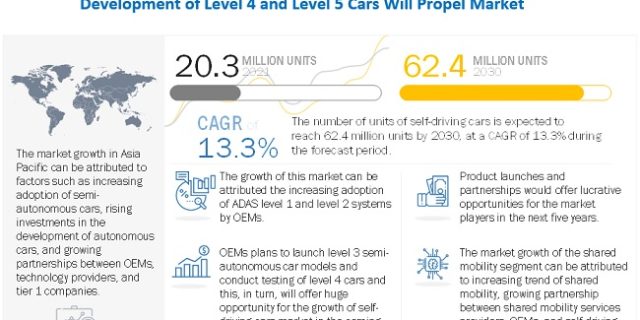
The autonomous / self-driving cars market size was valued at $20.3 Million in 2021, and it is expected to reach $62.4 Million by 2030, at a CAGR of 13.3% during the forecast period 2021-2030. Safety features are an important prerequisite for automotive customers across the world. Governments across the world have mandated the incorporation of features such as lane departure warning (LDW) and automatic emergency braking (AEB) paving way for new technologies and Autonomous / Self-driving cars . Different types of safety features have, therefore, been developed to assist drivers and lower the number of accidents. It is expected that the emergence of robo-taxis will be one of the key revenue-generating segment for Autonomous / Self-driving cars.
Increasing developments in autonomous shared mobility
Autonomous / Self-driving cars can operate with little or no human intervention. These vehicles are being developed for a reduction in accidents caused due to human errors, reduction in traffic congestion, and hassle-free transport. The development of autonomous vehicles will fuel the growth of ride-sharing. According to the Future of Driving report from Ohio University, with the use of autonomous taxis, the waiting time for a cab would come down from an average of 5 minutes to just 36 seconds. With autonomous ride-sharing, the cost of a ride would come down to just USD 0.5 per mile. For example, according to secondary research, Uber’s per ride charges are ~USD 2/mile, of which Uber takes ~50 cents, and USD 1.50 is with the driver. For an autonomous car or robo-taxi instead of a driver-driven car, Uber can straightaway charge a customer ~USD 1 per mile and earn additional ~50 cents per mile. However, the overhead costs such as the maintenance of a car, navigation, and payment services would be a part of it. Autonomous / Self-driving cars would also solve the problem of the first and last mile.
Request Free Sample Report @ https://www.marketsandmarkets.com/requestsampleNew.asp?id=1220
Introduction of AI-based camera systems for autonomous / self-driving applications
Numerous tier-1 suppliers and autonomous / self-driving car developers are focusing on the development and adoption of AI-based cameras as these systems offer safety features, such as adaptive cruise control, adaptive headlamp control, traffic sign recognition, forward collision warning, pedestrian detection, and automated braking. Advantages of AI camera systems include cost-savings, the fusion of various complementary technologies for reliable safety, and highly compact form factor.
Robert Bosch, one of the leading manufacturers of camera systems for Autonomous / Self-driving cars , has developed an AI-based camera MPC3 for autonomous / self-driving vehicles. The MPC3 marks a major stride toward autonomous / self-driving vehicles, an advance impelled mainly by artificial intelligence. The Bosch team took a multi-path approach to develop the camera. Its engineers and programmers created a software architecture that combines conventional image-processing algorithms with AI-driven methods and embedded it on a high-performance system-on-chip (SoC) with an integrated microprocessor. This enables peerless scene understanding and reliable object recognition. The AI camera works in three stages. The first path is the conventional approach already in use. With the help of machine learning, classifiers are trained to recognize and classify specific objects such as vehicles and pedestrians. In the second path, the camera taps into the optical-flow and structure-from-motion (SfM) imaging to detect raised objects bounding the road, such as curbstones. It computes three-dimensional structures based on corresponding points in images, the motion sequences of which are tracked. The third path puts artificial intelligence to good use. For another first in object detection, this new generation of multipurpose cameras can distinguish the roadway from the shoulder or identify discrete objects.
It uses neural networks and semantic segmentation that assigns each pixel of an image to a defined category. This is a huge advantage as road markings are no longer required to keep a autonomous / self-driving car safely on track. Errors can be minimized by combining all three detection paths.
The Asia Pacific region is projected to be the fastest-growing autonomous / self-driving cars market, by 2030
Asia Pacific is expected to account for the largest market share by 2030, followed by Europe and North America. Increasing demand for a safe, efficient, and convenient driving experience; rising disposable income in emerging economies; and stringent safety regulations across the globe are factors driving the autonomous / self-driving cars market. The market in Asia Pacific is expected to grow at the highest rate during the forecast period owing to increased partnerships adopted by Autonomous / Self-driving cars technology providers in this region. For example, Baidu is a major service provider of autonomous / self-driving technology in China. This company has already successfully test-driven more than 1 million miles in more than 13 Chinese cities. It is partnering with Ford and NVIDIA to increase investments for autonomous / self-driving vehicles in China. Asia Pacific also has one of the largest ride-sharing industries.
Asia Oceania region comprises countries such as China, Japan, India, South Korea and Thailand. In recent years, China has emerged as a hub for automobile production. Infrastructural developments and industrialization activities in emerging economies have opened new avenues, creating several opportunities for automotive OEMs. The growing technological advancements in China have increased the demand for semi-autonomous vehicles, which is going to increase the market for Autonomous / Self-driving cars.
Key Market Players
The autonomous / self-driving cars market is dominated by global players such as General Motors (US), Ford (US), Daimler (Germany), Volkswagen (Germany), Toyota (Japan) and Waymo (US). These companies have adopted strategies such as new product development, expansion, collaborations, partnerships, and mergers & acquisitions to gain traction in the Autonomous cars Market. Partnership and collaboration are the most widely adopted strategies by major players.
Inquire Before Buying @ https://www.marketsandmarkets.com/Enquiry_Before_BuyingNew.asp?id=1220

